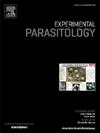Urine- and serum-based ELISA using a new recombinant chimeric protein to diagnose tegumentary and visceral leishmaniasis: a preliminary study
IF 1.4
4区 医学
Q3 PARASITOLOGY
引用次数: 0
Abstract
Laboratory diagnosis of leishmaniasis is hampered by the variable sensitivity and/or specificity of the tests. In the present study, we developed a new recombinant antigen based on a chimeric protein, called CHIMISA, which was composed of specific B-cell epitopes from Leishmania antigenic proteins recently identified in an immunoproteomics approach using sera samples from visceral leishmaniasis (VL) and VL/HIV co-infected patients. The protein was produced containing specific B-cell epitopes from four parasite proteins (SUZ41772.1, SUZ41881.1, AYU79515.1, and SUZ44007.1) and used as an antigen in ELISA with serum and urine samples for diagnosing VL, tegumentary leishmaniasis (TL), and VL/HIV co-infection. Paired serum and urine samples from healthy subjects and patients with other cross-reactive diseases were also used. The serum-based CHIMISA ELISA had 100 % sensitivity and 98.5 % specificity for diagnosing VL, TL and VL/HIV, with an area under the (AUC) value of 1.0. Soluble Leishmania Antigenic (SLA) extracts of Leishmania (Viannia) braziliensis and SLA of Leishmania (Leishmania) infantum were used as comparative antigens, and showed sensitivity values of 72.0 % and 44.0 %, respectively, and specificity values of 97.5 % and 98.1 %, respectively. The AUC values were 0.90 and 0.91, respectively. In the urine-based CHIMISA ELISA, sensitivity of 99.0 % and specificity of 98.1 % were reached, with an AUC of 0.99. SLA of L. (V.) braziliensis and SLA of L. (L.) infantum showed 65.6 % and 51.1 % sensitivity, respectively; and 96.9 % and 97.1 % specificity, respectively. The AUC values were 0.91 and 0.86, respectively. Although only a limited serological panel was used in this study, our preliminary data suggest that this new chimeric protein could be considered as a diagnostic candidate for VL, TL, and VL/HIV cases, using patient urine and serum.

利用一种新的重组嵌合蛋白的基于尿液和血清的酶联免疫吸附试验诊断皮肤和内脏利什曼病:初步研究
利什曼病的实验室诊断因检测的敏感性和/或特异性不同而受到阻碍。在本研究中,我们开发了一种新的基于嵌合蛋白的重组抗原,称为CHIMISA,该抗原由利什曼原虫抗原蛋白的特异性b细胞表位组成,该抗原是最近在免疫蛋白质组学方法中使用内脏利什曼病(VL)和VL/HIV合并感染患者的血清样本中发现的。该蛋白含有4种寄生虫蛋白(SUZ41772.1、SUZ41881.1、AYU79515.1和SUZ44007.1)的特异性b细胞表位,并作为ELISA抗原用于血清和尿液样本诊断VL、被膜利什曼病(TL)和VL/HIV合并感染。还使用了健康受试者和其他交叉反应性疾病患者的配对血清和尿液样本。基于血清的CHIMISA ELISA诊断VL、TL和VL/HIV的敏感性为100%,特异性为98.5%,AUC值为1.0。以巴西利什曼原虫(Viannia)和婴儿利什曼原虫(Leishmania)可溶性抗原(SLA)提取物作为比较抗原,敏感性分别为72.0%和44.0%,特异性分别为97.5%和98.1%。AUC值分别为0.90和0.91。以尿为基础的CHIMISA ELISA检测灵敏度为99.0%,特异性为98.1%,AUC为0.99。巴西乳鼠和幼年乳鼠的SLA敏感性分别为65.6%和51.1%;特异性分别为96.9%和97.1%。AUC值分别为0.91和0.86。虽然在这项研究中只使用了有限的血清学小组,但我们的初步数据表明,这种新的嵌合蛋白可以被认为是VL, TL和VL/HIV病例的诊断候选,使用患者的尿液和血清。
本文章由计算机程序翻译,如有差异,请以英文原文为准。
求助全文
约1分钟内获得全文
求助全文
来源期刊

Experimental parasitology
医学-寄生虫学
CiteScore
3.10
自引率
4.80%
发文量
160
审稿时长
3 months
期刊介绍:
Experimental Parasitology emphasizes modern approaches to parasitology, including molecular biology and immunology. The journal features original research papers on the physiological, metabolic, immunologic, biochemical, nutritional, and chemotherapeutic aspects of parasites and host-parasite relationships.
 求助内容:
求助内容: 应助结果提醒方式:
应助结果提醒方式:


